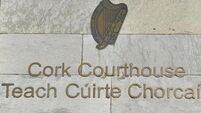Doctors 'gasped' when they saw four-year-old's injuries, court hears

The child’s stepmother, a woman in her 30s from the South-West, has pleaded not guilty to murder but guilty to the boy’s manslaughter in March 2021. Picture: iStock
When doctors pulled back the drapes to review the injuries of a four-year-old boy who, it is alleged, was murdered by his stepmother, “the whole theatre gasped”, the Central Criminal Court heard yesterday.
Stephen O’Riordan, a consultant paediatrician, said the child had significant bruises “from head to toe” which were consistent with physical abuse or non-accidental injuries.
He documented 17 areas of bruising or injury to both eyes, the ears, arms, legs, and back. “Black eyes”, combined with bruises around both ears are “classic signs of physical abuse”, he said.
A consultant intensive care doctor who gave evidence said the injuries the boy suffered would usually be associated with a crash where a car hits a wall, or a fall from a “very significant height”.
The child’s stepmother, a woman in her 30s from the South-West, has pleaded not guilty to murder but guilty to the boy’s manslaughter in March 2021.
Anne Rowland, prosecuting, said in her opening statement this week that it is the State’s case that the boy’s father and stepmother had kept the boy out of sight of other family members for several days due to bruises he had suffered from a series of assaults.
She said a pathologist will say that the child died due to a traumatic head injury in association with blunt force trauma to the stomach. The brain injury was caused by shaking, combined with contact with a flat surface, Ms Rowland said.
Mr O’Riordan described how he first came to treat the boy on March 13, 2021, when he was transferred by ambulance to hospital. The witness said he knew nothing more than that the boy had suffered a fall.
“We took the drapes away, and the whole theatre gasped,” he said.
Mr O’Riordan said the child’s father had said the black eyes were the result of two falls over the previous fortnight. Mr O’Riordan said: “Any fall in a four-year-old child that I would see regularly would never have two black eyes. One or the other, but having two would more likely be from a head injury.”
There were possible “grab marks” on one shoulder and to the left elbow, and multiple bruises on the back and chest, suggesting the boy was “landing on his chest or back a lot, which is consistent with non-accidental injury”.
The most significant, he said, was a “hugely extensive injury” to the back of the head, which the father said was caused by a fall from a top bunk onto a metal bed. Dr O’Riordan said it could “potentially” be caused by such a fall, but it would be hard to say, given the extent of the other injuries.
A laceration to the boy’s liver, Mr O’Riordan said, would have been caused by “extreme force” and would normally be associated with a car accident. X-rays carried out by another paediatrician showed the boy had previously suffered a fractured rib that was starting to heal.
The healing would suggest that the injury was seven to 10 days old, Mr O’Riordan said. This was “significant”, the doctor said, because it suggested the boy suffered trauma at a different time.
Mr O’Riordan said the number of unexplained injuries left him with a “significant concern” about physical or intentional abuse against the child.
Dr Niamh Mitchell, a specialist in emergency medicine, was working as a registrar at the time. She said the child had the most serious type of head injury.
Dr Mitchell inserted a urinary catheter, and as she did so, she noted multiple bruises on the child’s forehead, both eyes, his right arm, and significant bruises on both legs including on the inner thighs. The bruises were of different colours, she said, indicating they had been caused at different times.
She said: “It looked like he had been hit on more than one occasion, because of the different colours. It didn’t look like something you would get from normal play. The inside of the legs is not something you would injure in normal play.”
An intensive care consultant who treated the child said the dilated and unresponsive pupils indicated a traumatic brain injury. She said she did not receive a satisfactory explanation of the bruises from the child’s father, which gave her cause for concern. She said the father told her that the boy had been “grounded”, which she found “a little unusual for a child of that young age”.
The trial continues.











